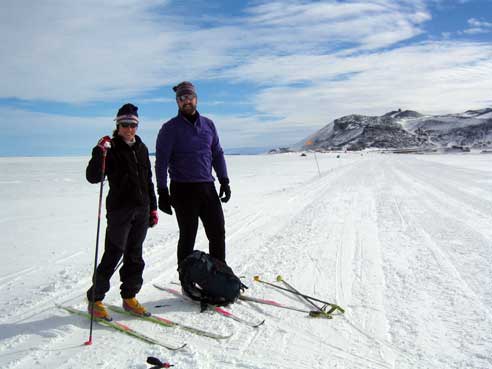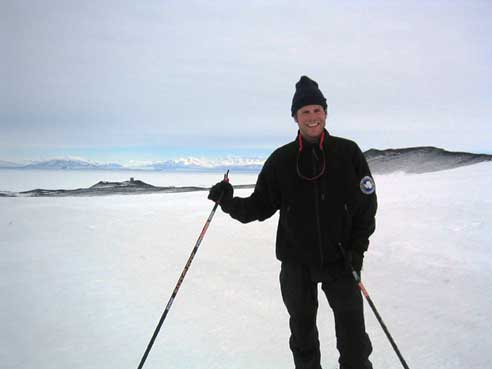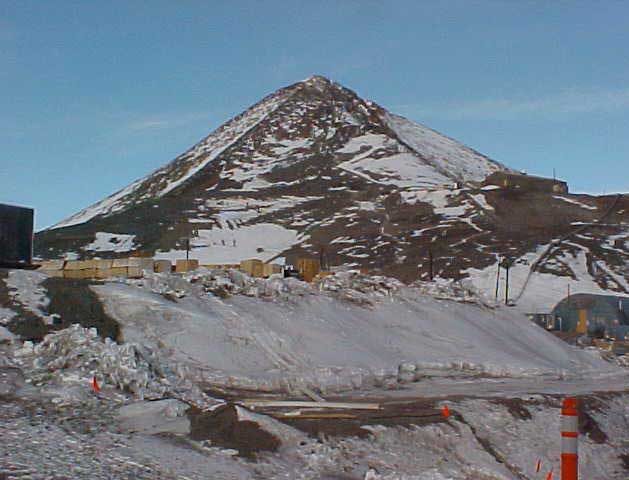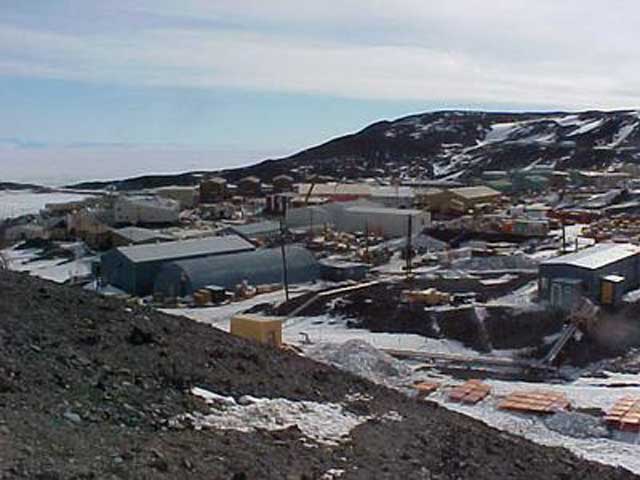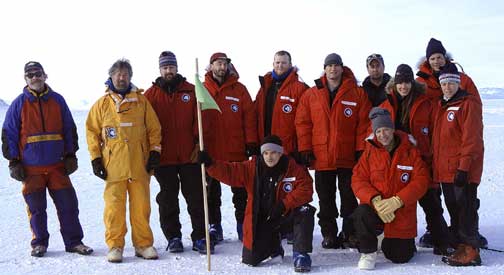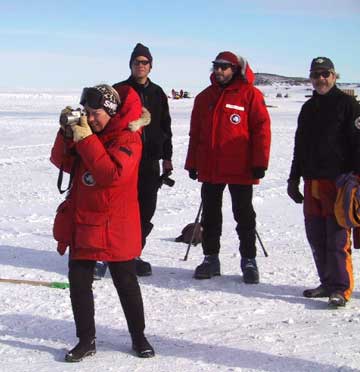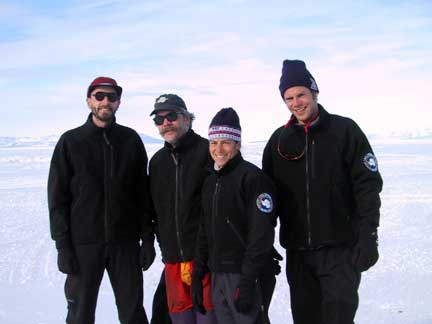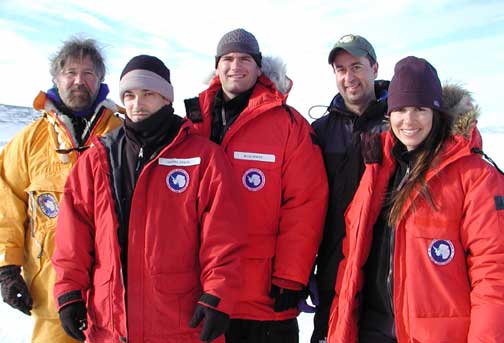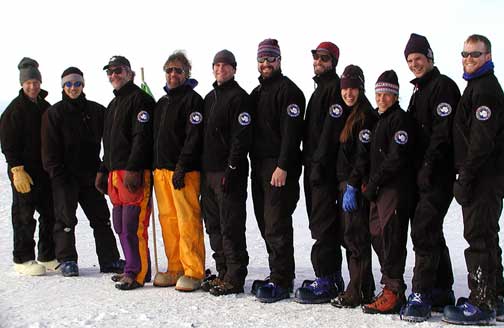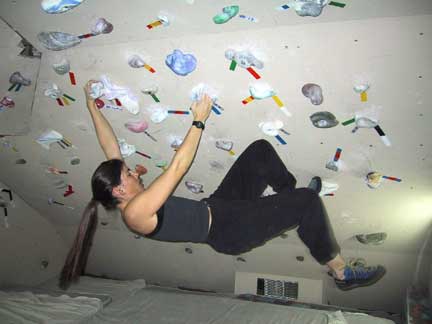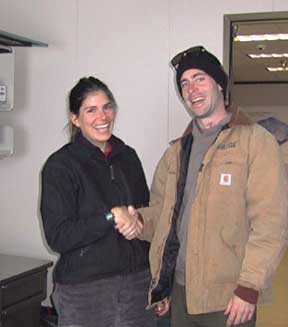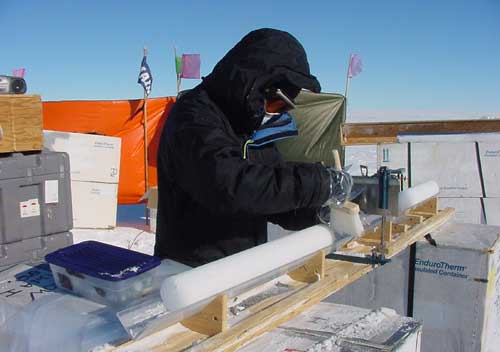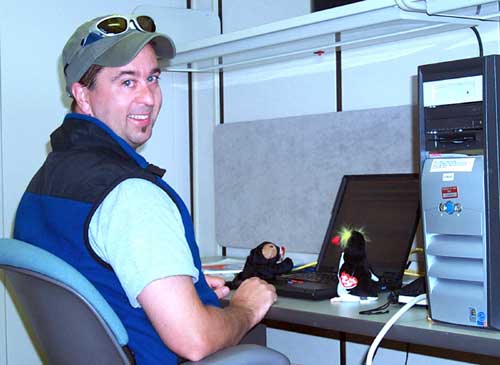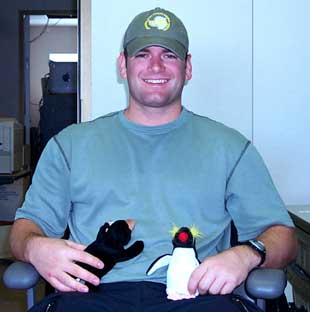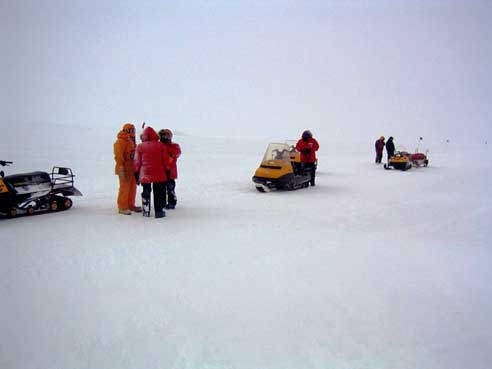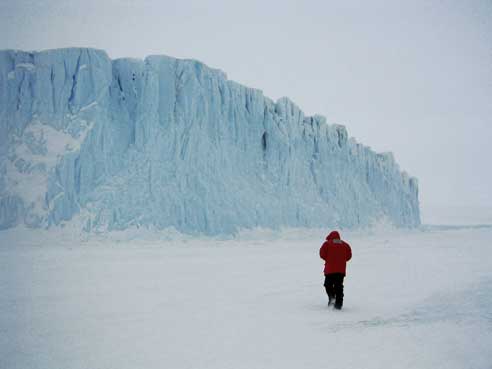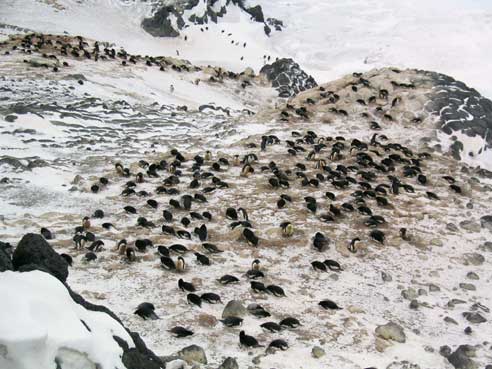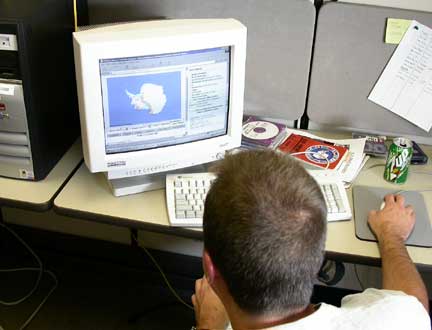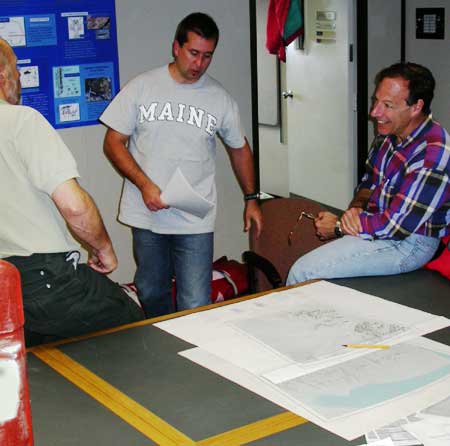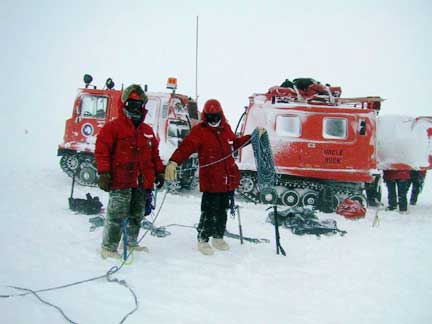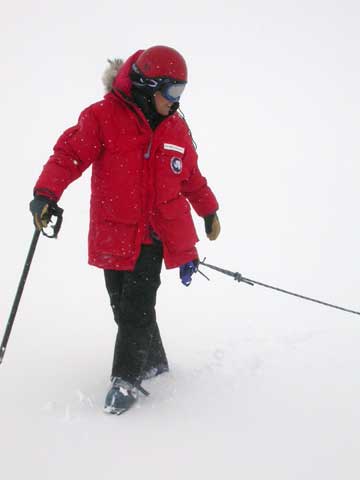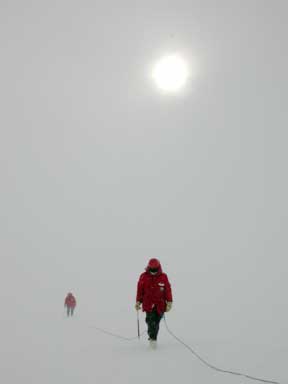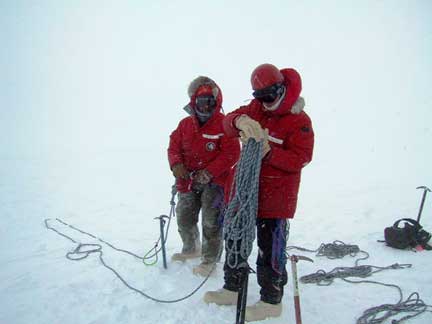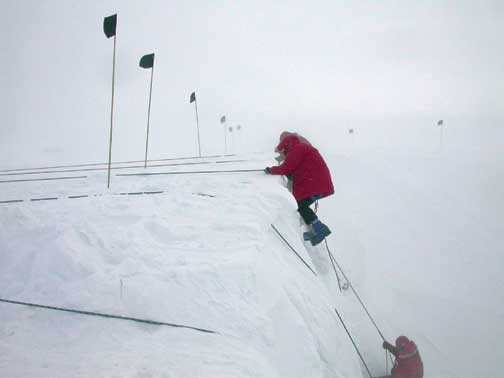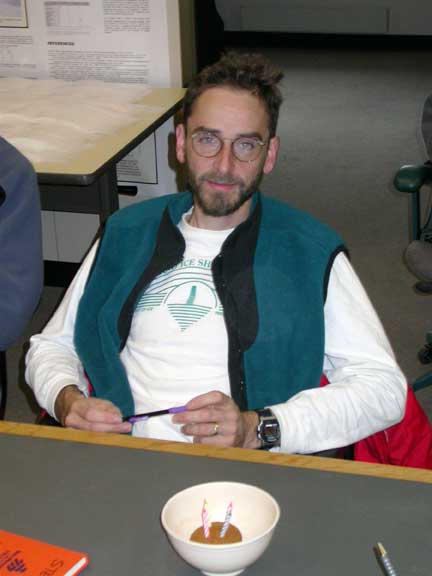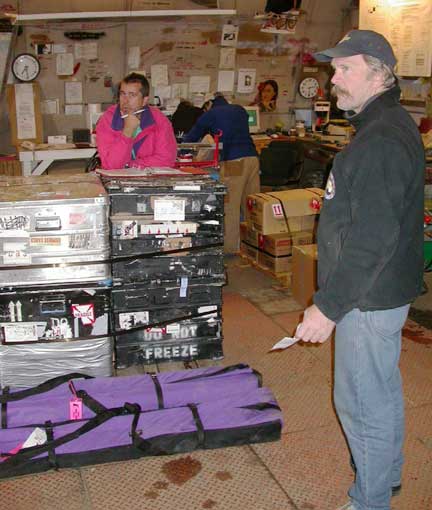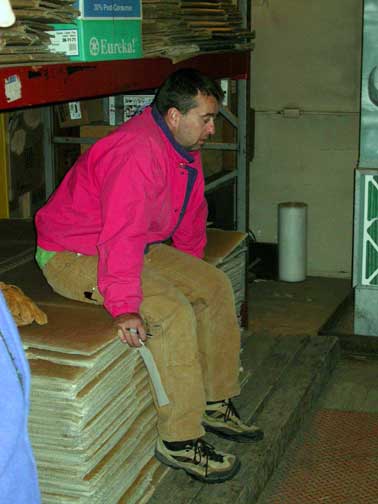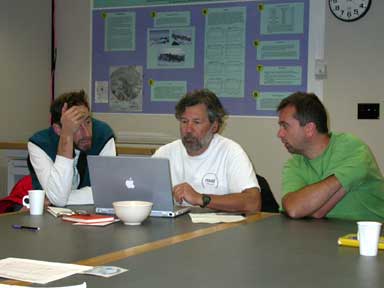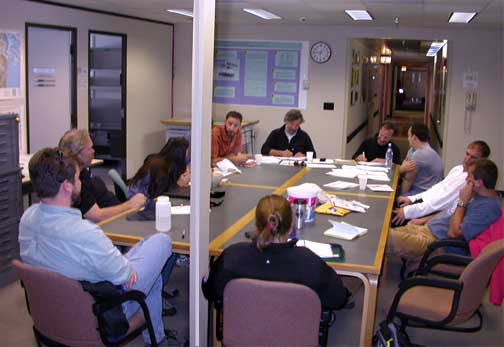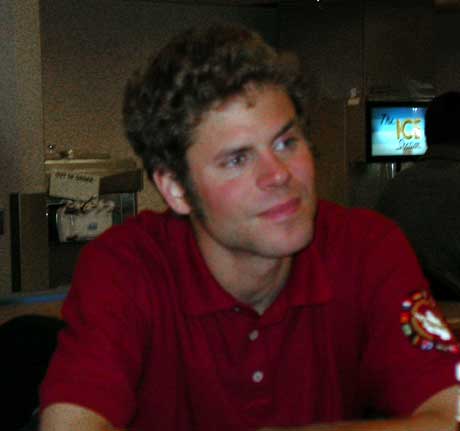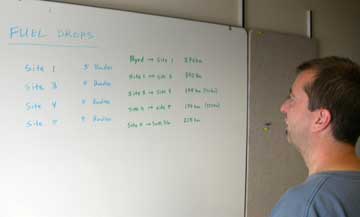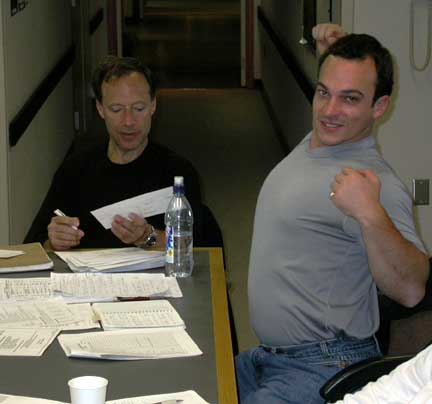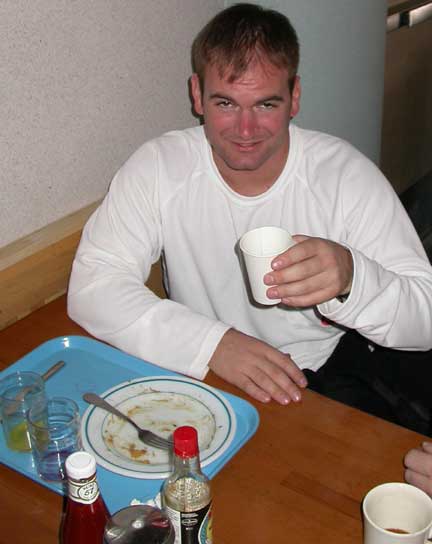
- 1999
- 2000
- 2001
- 2002
- 2003
- 2006
- 2007
Week 3 - November 11th to November 17, 2002
Date: 11/17/02
Latitude: 77 degrees, 51 minutes South
Longitude: 166 degrees 40 minutes East
Temperature: –6°C( 21°F)
Wind speed: 9 knots
Wind Chill: –12°C( 10°F)
Wind direction: Northwest
Meters of ice collected: 0
Notes on daily life:
Once again the weather has cooperated on a Sunday afternoon to make for some excellent recreational opportunities. We are now scheduled to depart on Tuesday. So after a meeting this morning where we reviewed logistics and plans, the team set out in all directions to enjoy the day. Some are hiking "Ob Hill" while others are skiing, walking the snow route to Scott Base or skiing the Castle rock loop. This is a healthy crowd; everyone seems to fit some sort of exercise or conditioning routine into their days here on the ice. It makes sense to keep in shape for the long days in the field. These days demand strength, endurance and fortitude in order to withstand the wind and cold. Many of the team members have amazing expeditions to foreign lands and extreme places in their resumes. These experiences add to the overall knowledge and comfort level of the group as we enter what I hope will be our final days of preparation for our departure into to deep field of Antarctica. Here is a quick summary of the some of the group’s highlights in the mountains and on the glaciers in pursuit of their field science research.
Paul, our expedition leader, first came to Antarctica thirty four years ago. In his early expeditions they often walked or snowmobiled their way across the snow, pulling wooden "Nansen" sleds behind them. In those days his expeditions lasted as many as 100 days in the field, twice the number of days of our expedition. Markus has skied in some pretty incredible territory in the Andes Mountains while conducting research on the ice of the Peruvian Glaciers and on volcanoes in Mexico. Eric Steig has skied and hiked in the high peaks of British Columbia. He also spent several months on Baffin Island collecting deep lake sediments. This is his 7th season in Antarctica and he has been to Summit, Greenland twice. Blue Spikes has some of the most interesting stories and experiences to share. He has been "all over the place" in Antarctica including Vostok, the Russian’s ice coring site, where he was in an airplane (called a Herc) that ran off the end of the runway and did a full 360 degree spin. He has also had the experience of falling in and getting out of crevasses on several occasions while conducting his geophysical research. Susan, being a native of Colorado, comes with extensive mountaineering and back country skiing experience. She was also a Forest Ranger, complete with the olive green outfit including a hat! She has been to Alaska and the Andes. Mark Wumkes, our chief drilling expert is from Fairbanks, Alaska. He has canoed from Minnesota to Alaska. He is also a multiyear veteran of Antarctica and Greenland. Others have been on Russian research vessels in the Arctic, dug in Dinosaur pits in Wyoming, flown, in helicopters in Alaska and Antarctica. This collective knowledge and number of days in the field gives us the confidence to roll with the setbacks and struggles of doing science in such difficult conditions. The physical conditioning prevents fatigue from clouding our minds while working for as many as 16 hours a day and sometimes for 72 hours without stopping.
I am excited to be with this group this year, and look forward to getting our expedition underway. I hope that there will be time while we are traveling to hear more of these veterans’ stories from their lives as "old Antarctic explorers".
Date: 11/16/02
Latitude: 77 degrees, 51 minutes South
Longitude: 166 degrees 40 minutes East
Temperature: –3°C( 27°F)
Wind speed: 3 knots
Wind Chill: –3°C( 27°F)
Wind direction: South
Meters of ice collected: 0
Notes on daily life:
The day began with a photo shoot for the ITASE team. At 9 am we met inour big red parkas and walked to the ice where Joan Myers, a photographer with the USAP artists and writers program shot many photos for our use.
We’re spending the day working in the lab, making phone calls and writing letters home, and enjoying the beautiful area that surrounds us. Some members of the team are skate skiing on the glacier and sea ice, and others have gone for walks on the ice free areas around the station. Our author today is Susan Kaspari, she is a veteran of four seasons in Antarctica and two ITASE traverses. Susan has had the opportunity to work in many rolls here in Antarctica.
Before beginning graduate school I spent two seasons in Antarctica as a support worker fueling aircraft. Yesterday during our field trip to Cape Royd I was reminded of my first season in Antarctica. I remember looking at the terminus of the Barne glacier and being in awe of its beauty and so curious about the forces that caused the glacier to form. I’m very thankful that I’m now able to come to Antarctica as a scientist to do research and learn about Antarctica, but I’m also thankful for my first two seasons as a support worker in McMurdo. For many scientists McMurdo is little more than a logistics hub, but after spending so much time here to me it feels more like a home away from home.
People in McMurdo work hard. The typical work schedule is to work 6 ten–hour days a week, with Sunday being a welcome day for rest and recreation. People work hard, but they play hard, too. To give an idea of the available facilities and things to do in McMurdo, there is a cardio gym, a weight lifting gym, a large gym used for soccer, volley ball and other sport leagues, a rock climbing wall and bouldering cave, a ceramics lab, two bars and a coffee house, a greenhouse, belly dancing lessons, yoga classes, dance lessons, live bands, frequent parties, bingo, a radio station, a bowling alley, political discussions, a chapel, art shows, poetry readings, phenomenal skate and classic skiing…. There’s always something to do in McMurdo.
The people that are attracted to working in Antarctica are generally high energy, adventurous people with a curiosity of the world, and this is what makes being part of the community so special. I worked hard as a support worker, but with such a great community of people work was fun and I felt like I was part of a family down here. Most scientists pass through McMurdo quickly on their way to the field and never experience this. Now I have the best of both worlds. I’m able to catch up with old friends while in McMurdo while following my dream to do Antarctic research.
We’re anxiously awaiting our departure to the field– we were told today that we are scheduled to leave on Tuesday. Two live bands are playing at Gallagher’s tonight (one of the pubs) so the team will have a night on the town. It’s Saturday night in MacTown…
Date: 11/15/02
Latitude: 77 degrees, 51 minutes South
Longitude: 166 degrees 40 minutes East
Temperature: –12°C( 10°F)
Wind speed: 11 knots
Wind Chill: –20°C( –5°F)
Wind direction: East
Meters of ice collected: 0
Notes on daily life:
Yesterday we had another waiting day here in McMurdo Station. The weather had deteriorated enough so that flights both in and out were canceled. Unfortunately, it was just too cold and windy to go on our outing to see the Penguin colonies at Cape Royds and the famous huts of early explorers Scott and Shakelton. I was disappointed that we had to postpone the field trip, but thankful for a day out of the wind and cold. Gordon Hamilton and I discussed route planning and logistics and we came up with the first of our web questions for our audience. How many barrels of fuel will the team need to make the traverse? The answer – 77.2 barrels of fuel are needed. But now for our second question. We have had 76 barrels of fuel dropped in the field for our refueling needs, do we have enough? How could this be?
This morning dawned partly cloudy, still cold and somewhat windy, but this is a rugged group, so eight of us bundled up in our cold weather gear and took off for a team field trip. Once again I found the experience to be an educational one that helped me become better prepared for the realities of our traverse to the South Pole. Preparations for this day long snow mobile trip to a location about thirteen miles from McMurdo included packing gear for overnight survival, extra fuel for our five snowmobiles and enough hot cocoa and snacks to keep us smiling! I was able to try out yet another clothing combination and to learn how quickly the weather conditions can change for the worse.
We got underway at about 10 am. Our little parade of five snowmobiles headed for our first stop, Cape Evans. This is the site of one of Sir Robert Scott's huts. It is the one most commonly seen in photographs. It is an awesome experience to have the opportunity to visit these places and to stand in the same rooms that the explorers who came before us stood in. I was impressed by how well preserved the place is. Being there made me feel as if they had just stepped out for a moment and would be back at any time, wondering whom this person in a huge red parka was walking around in their hut. A very creepy feeling came over me as I looked around. The beds look like they just stepped out of them and the science benches are waiting patiently for their return with samples from the field. Stores of food are on the shelves and empty cans and boxes are stored just out side the door.
After about an hour's stop at this Cape Evans we reloaded our trusty snowmobiles and zoomed off for our next vista, an enormous glacier edge. This glacier is gigantic; it dwarfed us with its presence and stunned us with its beauty. We gazed at it for a while and then moved on to our final destination, Cape Royds, the site of another historic hut and a large colony of Adelie Penguins.
By now the winds had picked up and it was getting even colder, but we were determined to see the penguins and hut. One of my goals for this trip was to see these adorable penguins. We parked our snowmobiles carefully, remembering to face them into the wind and to check their fuel levels before we headed off to see the Penguins. I practically ran with excitement over the small hill that lay between the birds and me. It's pretty hard to run in the big blue boots, however finding the birds is no problem, like any group of wild animals they have a strong smell. The winds were howling, making it difficult to stand on the hilltop to watch them, so we hid behind the rocks and silently watched these great creatures. Many of the birds too, were hunkered down, out of the wind, in small little balls of feathers. But many were up wandering about setting up their nests or socializing with one another. We would have stayed at this site much longer, but Paul recognized that the weather was deteriorating further and we had better get started for home.
The third and final stop on our outing was a visit to one of Shakelton's huts. This hut is also perfectly undisturbed. The sleeping bags of skin are on the beds, the pots for boiling water on the stoves. We had a look around this site and then began our long (one and one half–hour) snowmobile ride home into the blowing winds and snow. We kept close contact with one another as the weather came in around us reducing the visibility to only twenty or thirty feet ahead of us. Several times we stopped our progress and danced around to warm our hands and feet. As I gazed at the scenery around us, and the lack thereof, I tried to imagine how hard it must have been for the men who came to this place without our modern means of travel or fancy clothing. Experiencing the cold and wind while visiting these locations give us the chance to even more deeply appreciate the drive and determination of these earliest explorers. What courage they must have had in order to pursue science and exploration in this harsh and unforgiving, but beautiful place.
Date: 11/14/02
Latitude: 77 degrees, 51 minutes South
Longitude: 166 degrees 40 minutes East
Temperature: –13°C( 9°F)
Wind speed: 14 knots
Wind Chill: –23°C( –9°F)
Wind direction: East Northeast
Meters of ice collected: 0
Notes on daily life:
Our plan for today was to drive by snowmobile to Cape Evans and Cape Royds so that team members, especially the newer members, would get the feel for polar travel and start to get an idea of how their clothing would perform. At our early 7:00AM breakfast meeting however, we decided that the weather was really not very conducive to a long snowmobile ride and we canceled our trip. There will be plenty of opportunities for driving in blizzards once we get out into the field. With the day's planned activity canceled, team members spent the time taking care of small planning issues or working on material from home. There are also unconfirmed reports that some expedition members watched movies all day long or spent a few extra hours in a horizontal position in their rooms, catching up on sleep after early morning phone calls to the US.
Cape Evans and Cape Royds are historic landmarks in this part of Antarctica. Robert Falcon Scott established a hut at Cape Evans as a base camp for his fateful trek to the Pole. Ernest Shackleton established a smaller camp at Cape Royds for one of his Antarctic expeditions. Both huts remain in much the same condition they were left in by these explorers almost a century ago and are of enormous historical significance. They also serve as a graphic illustration of how things have changed from the so–called Heroic Age of Antarctic exploration to our modern period of polar expeditioning.
One of the most significant advances is that we are able to plan our traverse route ahead of time. Scott and Shackleton, on the other hand, used their compasses and sextants to keep heading south and had no prior knowledge of what conditions they would encounter along the way. For us, it is essential that we know what the traverse route looks like before going into the field. This is partly for safety reasons – we don't want to drive anywhere hazardous – and partly for scientific reasons – we want to visit the most interesting places and tailor our experiments at these sites ahead of time. The process of selecting this season's traverse route began several years ago when ITASE investigators chose to sample along a line from Byrd Station to the South Pole. Gordon Hamilton and Leigh Stearns then took that general idea and did a detailed route selection using high–resolution satellite imagery. The availability of high–resolution satellite imagery of the interior of Antarctica is itself a relatively recent thing. Radarsat only obtained the first complete continental coverage in October 1997.
Gordon and Leigh analyze Radarsat imagery for the presence of potential hazards along the route. Crevasses are the most significant hazard. These are stress cracks in the ice caused by flow (the same thing happens to the skin of cooling custard if you gently tip the bowl). Typical places where crevasses form are close to mountains where underlying bedrock disrupts the flow and where ice starts to speed up, such as near the heads of outlet glaciers. Using satellite imagery, we keep the traverse route a safe distance from those places. Gordon and Leigh also do a detailed analysis of the imagery to make sure there are no unusual fields of crevasses along the route (not every individual crevasse is visible from space, but because crevasses usually occur in swarms these are easier to detect). Route planning also includes work on drill site selection. The shading seen in satellite imagery tells us a lot about the shape, or topography, of the ice sheet surface, so that we can know ahead of time if we will be drilling in a bowl or on an inclined slope.
Once the details of the route were worked out, Paul and Gordon sat down in the spring to calculate how much fuel we would need. Obviously we need enough fuel to get us to our destination, but we don't want to carry too much extra fuel because it is heavy and takes up a lot of space. From our past experience we know that we travel 0.6 km on one gallon of fuel. This season's route is 1158 km long. Remembering that we have two vehicles that adds up to an awful lot of fuel. You might want to figure out how many barrels we will need to get from Byrd Station to the South Pole (each barrel holds 50 gallons of fuel) look for the answer tomorrow. The answer will be an astonishingly large amount of fuel – too much for us to carry all at once. To get around this, Gordon and Paul planned four sites along the route where an LC–130 aircraft parachuted fuel to the surface. We will pick up these fuel drums as we pass. The fuel calculations are further complicated because we learned from the aircrew that some of the parachutes did not open and so the fuel barrels may have been damaged on impact. Does that mean we should plan on carrying a few extra barrels from Byrd? As our planning stands now, in some cases we have a reserve of just three barrels on some sections of the traverse. It seems like taking a few extras would be a good idea, but remember that we are already carrying a lot of weight and volume. Planning an expedition is a delicate process.
Date: 11/13/02
Latitude: 77 degrees, 51 minutes South
Longitude: 166 degrees 40 minutes East
Temperature: –5°C( 23°F)
Wind speed: 30 knots
Wind Chill: –15°C( 4°F)
Wind direction: Southeast
Meters of ice collected: 0
Notes on daily life:
There are some things you learn but hope you'll never need to really use. The men and women who ventured into this place long ago were extremely rugged people. Many of these earlier explorers survived near death experiences because they were prepared for the worst and they remained calm and focused under the stress of an unexpected event. Today we often come to these places from our rather easy American lifestyles. Even in the little town of McMurdo it is easy to forget that you are in the last great wilderness on earth. Just around the corner from this cozy town lays thousand of miles of snowy wilderness. How do you move through this wilderness safely? Preparation.
In order to increase the level of safety for all missions on the continent, the US Antarctic Program offers several safety training classes. These range from chemical and workplace safety to snow and glacier survival school. Today Jim and I were given the chance for more Antarctic Preparation, Snow Craft 2, glacier travel and crevasse school. In this class, like snow craft 1 we began the class indoors with some explanation of knots and ropes and harnesses. Good thing since the weather turned antarctic today with strong winds and blowing snow. The comfort of a classroom is a much easier place to practice knot trying for the first time.
With the basics covered we packed into the Haglund tracked vehicle and drove off into the white world just outside the site of happy camper school. All was very white today. The snow and storm reduced the visibility to 20 feet and made it hard to tell what was an uphill and where the crevasses were located.
Upon arrival we roped up three to four persons for safe travel across the ice field. The howling winds and heavy clothes made it almost impossible to hear one another as we slogged across the snow and up the side of the glacier. About halfway up the hill, ice axes in hand our instructor, Brian Johnson, had us sit for a quick review of self–arrest technique using the ice axes. We then un–roped and practiced sliding down the hill as if we had fallen, rolling over and stuffing our axes into the snow. Several trips up and down the slope and we were confident in this new skill, vital to travel on a glacier or ice field.
We carefully worked our way back to the Haglunds, loaded up and drove to our next site, a crevasse, or crack in the ice sheet. The weather was deteriorating as we progressed and before we knew it we were in a whiteout. Brian, thinking he was driving straight had actually driven in a circle around the only building anywhere out in this area. As we crawled along in the snow storm, Jim observed that we had just circled the building. Fortunately, Brian was able to stop and gather his bearings by sticking his head out the window. We started up again driving towards the practice crevasse. I have to admit that at that point I put my helmet, gloves and parka on, I wasn't totally sure we weren't about to drive into the crevasse. If he couldn't see a building out there how was he going to see a crevasse? I was relieved when we arrived safely at the site and disembarked from the vehicles.
Our next challenge was crevasse rescue. For this exercise Brian threw his roped up backpack off the edge of the crevasse and we explored mechanical advantage and the benefits of having several pulleys to use when pulling a heavy load out of a big hole. Once we had learned how to anchor and set up Z drags we practiced rescuing duffel bags of heavy objects that "fell" off the edges of the crevasse. These rescue scenarios kept us warm and thinking in groups of 2 students to a duffel bag dummy.
By now the wind and weather were beginning to get even worse, so I was happy when Brian said it was time to go down into the crevasse and climb out. The crevasse offered shelter from the wind, and climbing would help bring up my body temperature. We tied in to the anchored ropes and easily used our new understanding our knots and ropes to ascend to the safety of the surface. We were now official graduates of Snow Craft 2! On our way "home" to McMurdo Station we celebrated by consuming large quantities of Oreo cookies and warm coffee.
While Jim and Betsy were off at snow school the rest of the group finalized packing and weighing the cargo that will fly with us to Bryd Station. The weather not only made snow school cold, but also has delayed our flight to Bryd Station for one day. We are now scheduled to depart Saturday, weather permitting.
Date: 11/12/02
Latitude: 77 degrees, 51 minutes South
Longitude: 166 degrees 40 minutes East
Temperature: –12°C( 10°F)
Wind speed: 14 knots
Wind Chill: –31°C( –24°F)
Wind direction: Northeast
Meters of ice collected: 0
Notes on daily life:
This morning started off with a quick birthday celebration for Eric Steig. Betsy was resourceful enough to have brought a birthday card for everyone to sign as well as candles to put in a muffin she got from the galley (9:00 was a little too early for cake). We spent the next hour or so updating one another on what we had accomplished so far and what each of us still needs done before we can fly out to Byrd Surface Camp to start the traverse.
After the morning meeting broke up it was back to our home away from home the science cargo yard. We were tasked with palletizing all of our cargo and packing loose ends into boxes. This required moving and repacking a huge amount of material; but with everyone pitching in it went smoothly.
After working all day in the cargo yard the team members went separate ways to enjoy some of their last free time in McMurdo. Blue and Gordon caught up on the latest college football scores prompting a vigorous debate as to whether Miami or Ohio State should be number one. Steve decided to be ambitious and went for a walk all the way across Ross Island to New Zealand's Scott Base, a cold but enjoyable endeavor. For many others the evening offered a chance to e–mail home, do some reading, or catch up on laundry.
The conversation topic of the evening in the galley was the storm that might be blowing into McMurdo tomorrow. This is particularly of note to the ITASE'ers because it could signal a delay in their planned departure date of Friday the 15th. If the snows do come Jim and Betsy will probably be most directly effected. The duo is slated to head out to the Silvercity Ice fall tomorrow for a course in glacier travel and crevasse rescue, but to Jim's relief they aren't scheduled to spend the night out again. That's the buzz from Mac– Town for now as everyone is eagerly awaiting Friday's Herc ride out of town and into the field.
Date: 11/11/02
Latitude: 77 degrees, 51 minutes South
Longitude: 166 degrees 40 minutes East
Temperature: –3°C( 27°F)
Wind speed: calm
Wind Chill: –3°C( 27°F)
Wind direction: n/a
Meters of ice collected: 0
Notes on daily life:
Happy Veteran's Day, and Happy Birthday to our own Dr. Eric Steig! The rest of the team has shown up on ice and the preparations for the trip have suddenly been thrust into high gear. The LC–130 that came in last night brought in not only the rest of the team (Paul, Steve, Eric, Brain, Gordon, Markus, Blue, and Mark) but also a lot of energy and excitement. Jim and Dan stayed up late last night to greet the weary new arrivals at midnight rations. After a quick late night meal and some greetings everyone retired to their dorm rooms to get ready for the busy day ahead.
Today started off with Paul convening a meeting of all the team members not yet in the field. It was a great opportunity to get everyone caught up to speed on the preparations that had already been completed and assign the few tasks left remaining. The amount of work that Carl, Lynn and Andrea invested into getting things ready before anyone else had even left the continent was phenomenal and will make preparations much easier on everyone now in McMurdo. However, there is always plenty to do.
For the new arrivals the first destination was the PUSH class, a refresher for snow school that will prepare the veterans to deploy to the deep field. Everyone also spent a lot of time making final checks on the cargo that had been sorted last week by Dan, Jim, Betsy, and Susan. The addition of the new team members has already had an impact in the daily routine in McMurdo. Offices that were once barren are now crowded with laptops and briefcases. Veteran ITASE members have had the chance to get to see old friends from previous visits to McMurdo and have also to get to know the two new faces joining the expedition this year. The galley has had to double the amount of food prepared for each meal now that Blue has joined Dan and Jim on their raids of the food lines.
Every one of the team members is chomping at the bit now as the realization that we will soon be leaving the comfort of Mactown and venturing out into the promise and potential of the unknown. If everything stays according to plan we'll be on the Herc Friday morning bound for Byrd Station where we'll rendezvous with Carl, Lynn, and Andrea and turn towards the uncertain excitement of the traverse.
